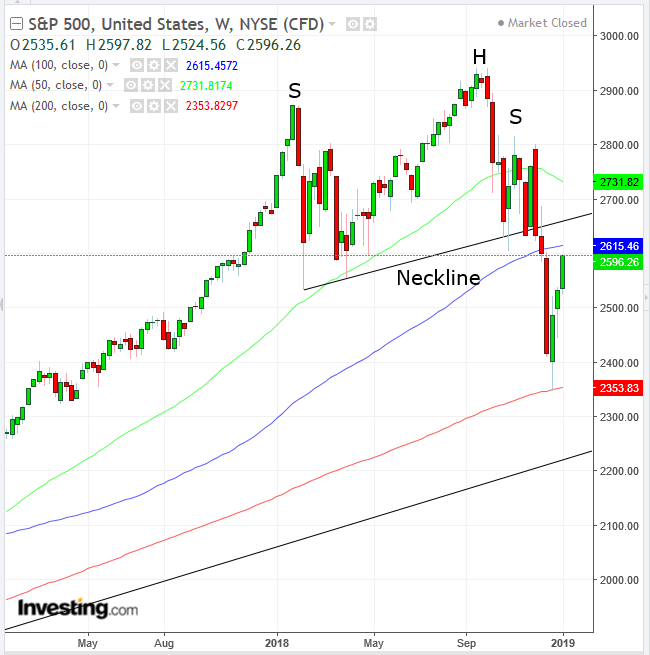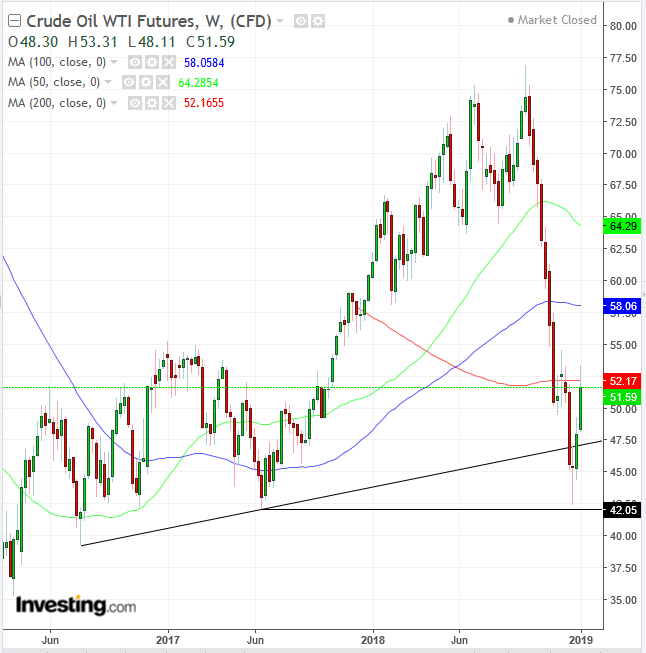- Large caps ended a five-day rally; small caps posted sixth day pf gains
- Oil ended nine-day advance, longest in nine years
- General Motors (NYSE:GM) bucks soft guidance trend
- Sectors suggest confusion
The five-day rally of US large cap indices—the S&P 500, Dow Jones Industrial Average and NASDAQ Composite—came to a halt on Friday, though the small cap Russell 2000 posted its sixth straight advance. Energy stocks tracked oil prices lower, ending nine days of gains, the longest winning streak for the sector in nine years.
The possibility of strength among automobile manufacturers, after an optimistic earnings forecast from General Motors (NYSE:GM) catapulted the stock higher on Friday, offered investors some hope after last quarter’s across-the-board softer guidance which extended into Apple’s recent announcement of an revenue shortfall in the current quarter. However, mounting concerns over the now-longest government shutdown in history offset what investors may have considered a bottom for company outlooks.
No Logic to Friday's S&P 500 Sector Advancers and Decliners
The S&P 500 Index slipped by 0.01 percent ahead of the weekend, with sectors split between red and green. However, there didn’t seem to be a logical delineation among the winners and losers.
Energy shares led the losses (-0.59%). That makes sense since oil tumbled below $52 a barrel on Friday. Otherwise, there wasn’t the classic divergence between cyclical and defensive sectors.
For example, defensive sector Consumer Staples was up (+0.29%) while Utilities fell (-0.37%). On the other side of the spectrum, cyclical sector Financials was up (+0.25%), while Communication Services (-0.5%) was down.
Another structural anomaly occurred between Financials (+0.25%) and Real Estate (+0.19%), both of which gained almost equally. However, Financial shares tend to rise when the outlook for higher interest rate increases, while Real Estate stocks typically fall with higher borrowing costs and relatively lower property income relative to higher fixed income yields. In other words, the negative correlation between the two sectors broke down on Friday.
Another market structure breakdown: both cyclical Consumer Discretionary (+0.1) and defensive Consumer Staples (+0.29%) were up.
A side note: it’s interesting that Materials (-0.4 percent) was among the bigger laggards, even as the president of the United States has consistently said he will not give up on his border wall, the biggest item among his campaign promises. One would expect that shares of Materials companies would rise in anticipation of the added business. After all, thus far, President Donald Trump has shown that he’s willing to go the distance for his promises, including the historic tax cut, the trade war and the border wall itself, as he faces off Democrats into the longest government shut down ever.
Also, while he seemed to take a step back from calling a national emergency about the matter, he continues threatening to take advantage of his executive privilege, which, once again, would benefit Materials. Could it be markets aren't convinced a $5B allocation for Trump's border wall is imminent?
On the other hand, Health Care shares, (+0.33%), may have gotten a boost from newly inaugurated California Governor Gavin Newsom, who, among other Democratic lawmakers at the state and city level, have proposed increased spending on healthcare among other items. Of course, given that California is the country's most populous state, this may have helped boost the sector.
All Sectors Green on Weekly Basis
For the week, the SPX advanced 2.54 percent, a third straight week of gains bringing the total upside to +7.43%, for the first time since August. All sectors were in the green. However, there's something to be learned about investor sentiment from how much they were willing to risk on various sectors.
Real Estate (+4%) outperformed, as one would expect after the outlook for a slower path of interest rate hikes became apparent. Financials (+1%), accordingly made a much small advance.
Cyclical sectors Industrials (+4.17%), Consumer Discretionary (3.72%) performed better.
Defensive sectors Consumer Staples (+0.72%) and Utilities (+0.87%) underperformed. Why then did Consumer Discretionary (+3.72%), a sector that includes luxury purveyors, end up among the top performers?
As well, Materials (+1.93%) were among the worst performers. Is this yet another signal investors may ultimately believe Trump will cave on this signature campaign promise?
The Dow was down 0.02% on Friday, but gained 2.4% on the week, for a third straight week of increases, totaling 6.91% since the December bottom.
The NASDAQ Composite's five day rally also ended, with the tech-heavy index falling -0.21% on the final day of trade. It gained 3.45% for the third consecutive week with a combined total of +10.08% across that timeframe.

The Russell 2000 (+0.13%) is the only major US index that continued its advance on Friday, for a sixth day. It gained 4.83% for the week and +12.02% for the three-week rally since the December bottom.
The Russell is also facing the resistance of a completed H&S top, but the big mystery is why the small cap index has been outperforming the other major US indices—on a myriad of time frames. It should have been hit hard by the enduring US-Sino trade talks. Is it a vote of no confidence by investors regarding the outcome of talks? Or are they not nearly as concerned about tariffs as the media and economists keep saying. The truth is, we don't actually know.

As for the S&P 500's Friday performance, is the sector disorientation temporary? Could it be a symptom of increased volatility not necessarily indicating anything other than haphazard profit-taking? Or is it a classic case of lack of leadership, as what could be the last rally within the bull market ebbs?
After the S&P 500 reached the 200 week MA, above the long-term uptrend line since the 2009 bottom we forecast another corrective rally, a return move toward the neckline of the massive H&S top that spans all of last year. This coming week might be the test.
Will the 2,700 level hold as a resistance? If so, we can expect another selloff, breaking the 20 percent bear market threshold, taking on the 200 week MA and the long-term uptrend line. However, if the government shutdown and the trade dispute are resolved, along with the more dovish Fed, we might see a H&S failure. This could act as a catapult—as market dynamics reverse—taking on the September record peak.Our money is on the preponderance of technical evidence, that the market will turn lower.

Oil completed a nine-day rally despite the US dropping four oil rigs last week as well as the longest stretch of US-Sino talks since the trade war began. Perhaps the ongoing US government shutdown began to wear on traders, or perhaps they simply considered it a good time to take profits, subsequent to all the headlines which focused on it being the longest rally for the commodity in almost a decade.
Technically, we can see that the price found increasing demand as it reached dual support, the June 2017 trough and an uptrend line, in place since August 2016, and the supply increase, which pushed it below the 200 week MA. A close above the 200 week MA would bolster confidence that the rebound could turn into a sustainable rally, while a fall below the $42 support since June 2017 will likely mean continued selloffs.
The Week Ahead
Monday
2:00: China – Tentative: Imports and Exports (December): trade balance seems to worsen, as imports are expected to rise to 5.5 from 3% YoY, while exports are seen to fall to 3% from 5% YoY.
9:00: US – Tentative: Fed Chair Powell Testifies: perhaps investors will get some clarity after Powell’s drastic about-face regarding the path to tightening. As well, on Friday he said he was “very worried” about the growing amount of debt in the country. Total US. debt is about $21.9 trillion, of which $16 trillion is owed by the public. Might this impact the rate trajectory, as continued rate increases under Powell could elevate the cost of interest on that debt which would then become a bigger and bigger burden. The sustained annual US deficit is now believed to be more than $1 trillion.
Tuesday
8:30: US – Tentative: Trade Balance (November): deficit to narrow to $54 billion from $55.5 billion
8:30: US – NY Empire State Manufacturing Index (January): forecast to rise to 11.25 from 10.9
Evening: UK – Parliament to vote on Brexit deal: the House of Commons will vote on the PM’s Withdrawal Deal. It is still unclear whether it will pass, and the future is uncertain if it fails. Market to watch: GBP crosses
Wednesday
2:00: Germany – CPI (December, Final): forecast to stay flat at 0.1% MoM and 1.7% YoY
4:30: UK – CPI (December): prices expected to decline to 2.2% from 2.3% YoY
8:30: US – Retail Sales (December): sales to stay fat at 0.2% MoM
10:30: US – EIA Crude Inventories (w/e 11 January): stockpiles to fall to -2.800M
Thursday
5:00: Eurozone – CPI (December): expected to stay flat 1.6% YoY and -0.2% MoM
8:30: US – Housing Starts: to be 1.260M from 1.256M
8:30: US – Building Permits (December): expected to fall to -2.1% from 5.0% MoM and 1.290M from 1.328M YoY
10:00: US – New Home Sales (November): forecast to rise to 569K from 544K
18:30: Japan – CPI (December): prices to rise 1.3% YoY from 0.8
Friday
4:30: UK – Retail Sales (December): forecast to fall to -0.8% from 1.4% MoM and fall to 3.4% from 3.6% YoY
8:30: Canada – CPI (December): core forecast to rise 2.3% YoY from 1.5%.
10:00: US – Michigan Consumer Sentiment (December, preliminary): confidence to fall to 96.9 from 98.3.
